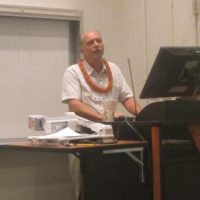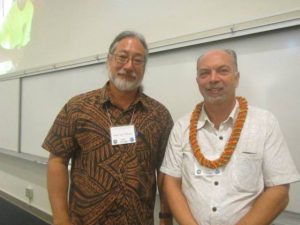
“A History of the Development and Use of the Samoan Fautasi,” was the topic of a keynote speech delivered by American Samoa’s Historic Preservation Officer, David J. Herdrich in Hawaii last week.
This was at the 28th Annual Symposium on the Maritime Archaeology and History of Hawai’i and the Pacific on February 18th.
This year’s theme was “Early Watercraft and Maps: Voyaging, Visualizing, and Revitalizing.”
The conference in Hawaii is an annual event, sponsored by the National Oceanic and Atmospheric Administration (NOAA) Office of National Marine Sanctuaries, the University of Hawaii, and the local non-profit foundation the Maritime Archaeology and History of the Hawaiian Islands Foundation (MAHHI).
Herdrich’s presentation was in collaboration with Dr. Hans Van Tilburg, maritime archaeologist and historian for NOAA, Dr. Michaela Howells, Assistant Professor of Biological Anthropology at the University of North Carolina at Wilmington (UNCW), and Mr. Michael David Coszalter an anthropology undergraduate at UNCW.
It examined the origin, development and use of the Samoan fautasi with special reference to the taumualua (two bowed paddling war canoes) that preceded them.
The talk described the origin of fautasi and the evolution of popular racing events today in the context of hybrid nautical design, European colonialism and modern globalization. 
Herdrich discussed how previous descriptions of the development of the fautasi were oversimplified, depicting fautasi merely as European boats replacing taumualua when warfare in the Samoan islands ended.
In fact, fautasi developed as a European/Samoan hybrid design, that were faster than the taumualua, and were from the very beginning used as war boats, cargo and passenger boats, V.I.P. Boats, and racing boats.
Research dates the earliest known origin of the fautasi to 1894.
The following year because every Samoan village wanted them, there was a fautasi building boom.
Samoan and New Zealand boat builders designed and built them, and some were imported from New Zealand shipyards.
Some fautasi, built in the late 1890s, were as long as 120 feet, and in once case, 156 feet in length.
After American Samoa became a territory in 1900, the Naval Administration issued regulations in 1903 that restricted traditional Malaga, preventing the use of fautasi for inter-island transport.
Eventually, racing became the sole function for fautasi.
Herdrich described how fautasi racing has become one of single largest cultural events in American Samoa, and shared his personal experience in being a crewmember of the Executive Offices fautasi during the 2016 Flag Day celebrations.
His presentation corrected a misperception that fautasi are merely “European boats,” demonstrating that they are an important part of Samoan culture and history.
Herdrich said his presentation was well received and garnered great interest and many questions from participants at the Symposium.
The research was supported by funding from the National Park Service Historic Preservation Fund and NOAA.




